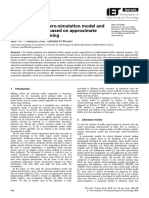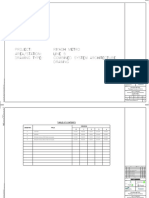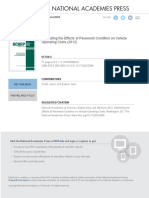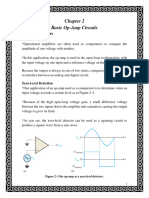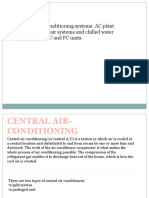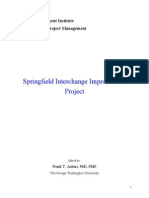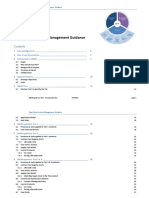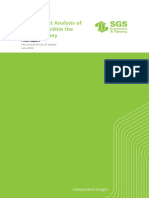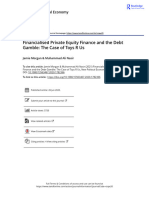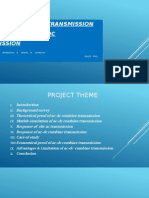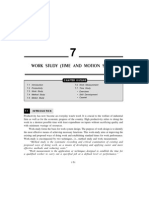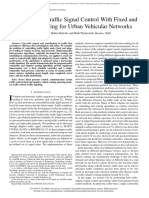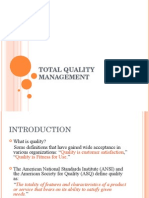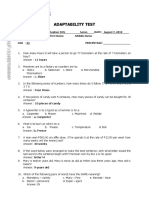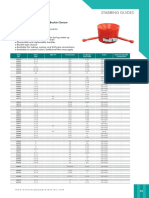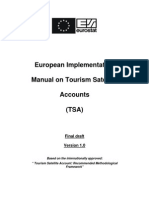DSM CPA Reviews Center B5 – Performance Management CPA, David D Kiwia
CHAPTER TWO
COST ESTIMATION AND LEARNING CURVE
I. COST ESTIMATION
Cost Estimation is the process of classifying or separating the cost by behavior (ie variable and
fixed cost) so as to have a cost function that can be used to predict cost at any activity level.
Cost function is the mathematical formular that is used to predict cost at different levels of output.
It is derived from historical cost data. Once a cost function has been established, after separating
the fixed and variable costs using the cost estimation methods, it can be used to estimate future
costs.
Cost equations are assumed to have a linear function and therefore the equation of a straight line
can be applied:
y = a + bx
Where:
• ‘a’ is the intercept, i.e. the point at which the line y = a + bx cuts the y axis (the value of y
when x = 0).
• ‘b’ is the gradient/slope of the line y = a + bx (the change in y when x increases by one
unit).
• ‘x’ = independent variable.
• ‘y’ = dependent variable (its value depends on the value of ‘x’).
This formula can be related to the results of the high/low calculation as follows:
• ‘a’ is the fixed cost per period – TFC (the intercept)
• ‘b’ is the variable cost per unit - Vcu (the gradient or slope)
• ‘x’ is the activity level (the independent variable)
• ‘y’ is the total cost = fixed cost + variable cost (dependent on the activity level)
Suppose a fixed costs for a particular period are £5000, the average unit variable cost is $10, and
direct labour hours represent the cost driver, then:
1|Page
Kiwia, David D. CPA-T, BAF, MFA-OG PhD- Accounting (IP) . kiwiadavid09@gmail.com 0716 734 577
DSM CPA Reviews Center B5 – Performance Management CPA, David D Kiwia
A cost equation will be y = $5,000 + 10x, this can be shown graphically as follows:
The following approaches to cost estimation will be examined:
a) Engineering methods;
b) Inspection of the accounts method;
c) Graphical or scatter graph method;
d) High–low method;
e) Least-squares method.
These approaches differ in terms of the costs of undertaking the analysis and the accuracy of the
estimated cost functions. They are not mutually exclusive and different methods may be used for
different cost categories.
A. Engineering methods
• Engineering methods of analyzing cost behaviour are based on the use of engineering
analyses of technological relationships between inputs and output.
2|Page
Kiwia, David D. CPA-T, BAF, MFA-OG PhD- Accounting (IP) . kiwiadavid09@gmail.com 0716 734 577
DSM CPA Reviews Center B5 – Performance Management CPA, David D Kiwia
• The approach is appropriate when there is a physical relationship between costs and the
cost driver.
• The engineering method is useful for estimating costs of repetitive processes where input–
output relationships are clearly defined.
• For example, this method is usually satisfactory for estimating costs that are usually
associated with direct materials, labour and machine time, because these items can be
directly observed and measured.
B. Inspection of the accounts method;
The inspection of accounts method requires that the departmental manager and the accountant
inspect each item of expenditure within the accounts for a particular period, and then classify each
item of expense as a wholly fixed, wholly variable or a semi-variable cost. One problem with this
method is that the analysis of costs into their variable and non-variable elements can be very
subjective.
C. Graphical or scatter graph method
This method involves plotting on a graph the total costs for each activity level. The total cost is
represented on the vertical (Y axis) and the activity levels are recorded on the horizontal (X axis).
A straight line is fitted to the scatter of plotted points by visual approximation.
The graphical method is simple to use, and it provides a useful visual indication of any lack of
correlation or erratic behaviour of costs. However, the method suffers from the disadvantage that
the determination of exactly where the straight line should fall is subjective, and different people
will draw different lines with different slopes, giving different cost estimates. To overcome this
difficulty, it is preferable to determine the line of best fit mathematically using the least-squares
method.
D. High–low method
The high–low method consists of selecting the periods of highest and lowest activity levels and
comparing the changes in costs that result from the two levels. The non-variable (fixed) cost can
be estimated at any level of activity (assuming a constant unit variable cost) by subtracting the
variable cost portion from the total cost as illustrated in Chapter one of this book.
3|Page
Kiwia, David D. CPA-T, BAF, MFA-OG PhD- Accounting (IP) . kiwiadavid09@gmail.com 0716 734 577
DSM CPA Reviews Center B5 – Performance Management CPA, David D Kiwia
You will see from this illustration that the method ignores all cost observations other than the
observations for the lowest and highest activity levels. The high–low method is not the most
accurate method. To overcome this difficulty, it is preferable to determine the line of best fit
mathematically using the Regression method (least-squares method).
E. Regression Method (Least-Squares Method)
This is a mathematical method of determining the regression line of best fit. The least squares
method is based on the principle that the sum of the squares of the vertical deviations from the line
that is established using the method is less than the sum of the squares of the vertical deviations
from any other line that might be drawn.
The general equation describing a line is: Y = a + bX
Where by:
n∑xy − ∑x∑y−
𝐛= 2 2
n∑x −(∑x)
∑y ∑x
a= -b
n n
For example the past observations of maintenance costs is as follows. You are required to prepare
the cost estimation question by using regression method.
Hours X Maintenance X2 Xy
Cost Y (TZS)
90 1500 8100 135 000
150 1950 22 500 292 500
60 900 3 600 54 000
30 900 900 27 000
180 2 700 32 400 486 000
150 2 250 22 500 337 500
120 1 950 14 400 234 000
180 2 100 32 400 378 000
90 1 350 8 100 121 500
30 1 050 900 31 500
120 1 800 14 400 216 000
60 1 350 3 600 81 000
∑x=1260 ∑y=19800 ∑x2=163 800 ∑xy=2394000
4|Page
Kiwia, David D. CPA-T, BAF, MFA-OG PhD- Accounting (IP) . kiwiadavid09@gmail.com 0716 734 577
DSM CPA Reviews Center B5 – Performance Management CPA, David D Kiwia
Y = a + bX
n∑xy − ∑x∑y 12 x 2 394 000 − 1260 x 19 800
b= − = − = TZS10
n∑x2 −(∑x)2 12x163 800 −( 1260)2
∑y ∑x 19 800 1260
a= -b = - 10x = TZS 600
n n 12 12
Substituting these values of a and b into the regression equation y = a +bx, we find that the
regression line can be described by
Y = 600 + 10x
5|Page
Kiwia, David D. CPA-T, BAF, MFA-OG PhD- Accounting (IP) . kiwiadavid09@gmail.com 0716 734 577
DSM CPA Reviews Center B5 – Performance Management CPA, David D Kiwia
II. LEARNING CURVE
The predominant assumption so far has been that total costs can be estimated using a straight line
formula y = a + bx. This might not always be the case and sometimes total costs might be non-
linear, one cause of non-linear costs is the learning curve phenomenon.
The speeding up of a job with repeated performance is known as the learning effect or learning
curve effect and the reduction in the required direct labour time for a job may be quantified. As
the operation is repeated, the workers become familiar with the work, labour efficiency increases
and the labour cost per unit declines.
The learning process starts from the point when the first unit comes off the production line, from
then on, each time cumulative production is doubled, and the average time taken to produce each
unit of cumulative production will be a certain percentage of the average time per unit of the
previous cumulative production.
A learning curve is a graphical representation of relationship between a learner's performance on
a task and the number of attempts or time required to complete the task.
The learning curve theory proposes that a learner’s efficiency in a task improves over time the
more the learner performs the task. As such a learning curve is a nonlinear function (exponential
function) that shows how labour hours per unit decreases as unit of output increases.
Learning Curve
Chart line representing the efficiencies gained from experience. Basically, it is a curve describing
the relationship between the consecutive numbers of units produced (x-axis) and the time per unit
produced (y-axis). More specifically, it is based on the statistical findings that as the cumulative
output doubles, the cumulative average labour input time required per unit will be reduced by some
constant percentage, ranging between 10% and 40%. The curve is usually designated by its
complement. For example, if the rate of reduction is 20%, the curve is referred to as an 80%
learning curve.
The learning rate
The cumulative average time per unit produced is assumed to fall by a constant percentage every
time total output double.
6|Page
Kiwia, David D. CPA-T, BAF, MFA-OG PhD- Accounting (IP) . kiwiadavid09@gmail.com 0716 734 577
DSM CPA Reviews Center B5 – Performance Management CPA, David D Kiwia
For example, the first unit of output requires 100 hours and 80% learning curve applied, the
production time would be as follow
Number of Unit Cumulative average time Total time required Incremental time for
produced required Per unit hours hrs additional unit hours
1 100 (100 x 1) = 100 0
2* (80% x100) = 80 80hrs x 2 =160 60 (for 1 extra)
4* 64hrs x 4=256 (80% x 80) = 64 96 (for 2 extra)
8* (80% x 64) =51.2 51.2hrs x 8=409.6 153.6(for 4 extra)
16* (80% x 51.2) =40.96 40.96 x 16 = 655.36 245.76 (for 8 extra)
Note * output is being doubled each time
Assumptions of learning curve Theory
• The work is manual
• The work is continuous
• The work is repetitive in nature
• No labour turnover
• No change in technology
• No change in production process
Limitations of learning curve theory
• It assumes stable conditions at work, which will enable learning curve to take place. This
is not always practicable ( eg because of labour turnover)
• It must also assume a certain degree of motivation amongst employees
• It might be difficult to obtain enough accurate data to decide what the learning curve is
• There will be a cessation to learning curve eventually, once the job has been repeated often
enough
Application of learning curve theory in management accounting
Applications of the learning curve theory include the following;
• Pricing decisions, based on the estimates of expected costs;
• Requirements for scheduling labour;
• Capital budgeting decisions;
• Setting incentive wage rates.
7|Page
Kiwia, David D. CPA-T, BAF, MFA-OG PhD- Accounting (IP) . kiwiadavid09@gmail.com 0716 734 577
DSM CPA Reviews Center B5 – Performance Management CPA, David D Kiwia
• To calculate the marginal (incremental) cost of making extra unit of a product
• To quote selling prices for a contract, where prices are calculated at cost plus a percentage
mark up for period
• To prepare realistic production budgets
• To compare budgeted and actual costs and report cost variances
Learning Curve Formular
The learning curve can be expressed in equation form
The formula for the learning curve is Y = aXb,
Where by;
• Y is the cumulative average time per unit to produce x units
• X is the cumulative number of units
• a is the time taken for the first unit of output
• b is the index of learning (log of the learning rate/log of 2)
• LR is the learning rate as a decimal
Example:
Assume that the learning rate for a certain operation is 75% and it took 90 hours to produce the
first unit. Calculate the hours required to produce the fifth unit.
By substituting the given data value into C equation, we get
Using the above value and the specified data in Y = aXb yields
b = log 0.75/log 2 = - 0.4150
Y = 90 x (5)-0.4150
= 46.15 hours
It will take 46.15 hours to produce the fifth unit
Learning Curve and Production in Terms of Batches
8|Page
Kiwia, David D. CPA-T, BAF, MFA-OG PhD- Accounting (IP) . kiwiadavid09@gmail.com 0716 734 577
DSM CPA Reviews Center B5 – Performance Management CPA, David D Kiwia
In case production occurs in terms of batches, then the number of batches will be regarded as “X”
in the learning curve formular and hours taken by the first batch will be regarded as “a”
Recall
Y = aXb
a = Hours taken by the first batch
x – The number of batches
b – The learning index,
b = logLR/log2
REVIEW QUESTIONS
Question One
BFG Limited is investigating the financial viability of a new product the S-pro. The S-pro is a
short-life product for which a market has been identified at an agreed design specification. The
product will only have a life of 12 months.
The following estimated information is available in respect of S-pro:
• Sales should be 1,200 units in the year. An average selling price of $1,050 per unit is
expected. All sales are for cash.
• An 80% learning curve will apply for the first 700 units after which a steady state
production time will apply, with the labour time per unit after the first 700 units being equal
to the time for the 700th unit. The cost of the first unit was measured at $2,500. This was
for 500 hours at $5 per hour.
• Variable overhead is estimated at $2 per labour hour.
• Direct material costs will be $514,000 for the year. All purchases are made for cash. A
target net cash flow of $350,000 is required in order for this project to be acceptable.
Required
9|Page
Kiwia, David D. CPA-T, BAF, MFA-OG PhD- Accounting (IP) . kiwiadavid09@gmail.com 0716 734 577
DSM CPA Reviews Center B5 – Performance Management CPA, David D Kiwia
a) Prepare detailed calculations to show whether product S-pro will provide the target net
cash flow. (9 marks)
b) Calculate what length of time the second unit will take if the actual rate of learning is:
i. 80%;
ii. ii. 90%. Explain which rate shows the faster learning. (5 marks)
c) Suggest specific actions that BFG could take to improve the net cash flow calculated above.
(6 marks)
(Total = 20 marks)
Question Two
Chair Co has developed a new type of luxury car seat. The estimated labour time for the first unit
is 12 hours but a learning curve of 75% is expected to apply for the first eight units produced. The
cost of labour is $15 per hour. The cost of materials and other variable overheads is expected to
total $230 per unit.
Chair Co plans on pricing the seat by adding a 50% mark-up to the total variable cost per seat,
with the labour cost being based on the incremental time taken to produce the 8th unit.
Required:
a) Calculate the price which Chair Co expects to charge for the new seat.
Note: The learning index for a 75% learning curve is –0·415. (5 marks)
b) The first phase of production has now been completed for the new car seat. The first unit
actually took 12·5 hours to make and the total time for the first eight units was 34·3 hours, at
which point the learning effect came to an end. Chair Co are planning on adjusting the price to
Required:
i) Calculate the actual rate of learning and state whether this means that the labour force
actually learnt more quickly or less quickly than expected. (3 marks)
ii) Briefly explain whether the adjusted price charged by Chair Co will be higher or lower
than the price you calculated in part (a) above. You are NOT required to calculate the
adjusted price. (2 marks)
(10 marks)
10 | P a g e
Kiwia, David D. CPA-T, BAF, MFA-OG PhD- Accounting (IP) . kiwiadavid09@gmail.com 0716 734 577
DSM CPA Reviews Center B5 – Performance Management CPA, David D Kiwia
Question Three
Henry Company (HC) provides skilled labour to the building trade. They have recently been asked
by a builder to bid for a kitchen fitting contract for a new development of 600 identical apartments.
HC has not worked for this builder before. Cost information for the new contract is as follows:
Labour for the contract is available. HC expects that the first kitchen will take 24 man-hours to fit
but thereafter the time taken will be subject to a 95% learning rate. After 200 kitchens are fitted
the learning rate will stop and the time taken for the 200th kitchen will be the time taken for all the
remaining kitchens. Labour costs $15 per hour.
Overheads are absorbed on a labour hour basis. HC has collected overhead information for the last
four months and this is shown below:
Hours worked Overhead
Month 1 9,300 cost $
115,000
Month 2 9,200 113,600
Month 3 9,400 116,000
Month 4 9,600 116,800
HC normally works around 120,000 labour hours in a year. HC uses the high low method to
analyse overheads.
Required
a) Describe THREE factors, other than the cost of labour and overheads mentioned above, that
HC should take into consideration in calculating its bid. (6 marks)
b) Calculate the total cost including all overheads for HC that it can use as a basis of the bid for
the new apartment contract. (12 marks)
c) If the second kitchen alone is expected to take 21·6 man-hours to fit demonstrate how the
learning rate of 95% has been calculated. (2 marks)
(Total = 20 marks)
11 | P a g e
Kiwia, David D. CPA-T, BAF, MFA-OG PhD- Accounting (IP) . kiwiadavid09@gmail.com 0716 734 577


